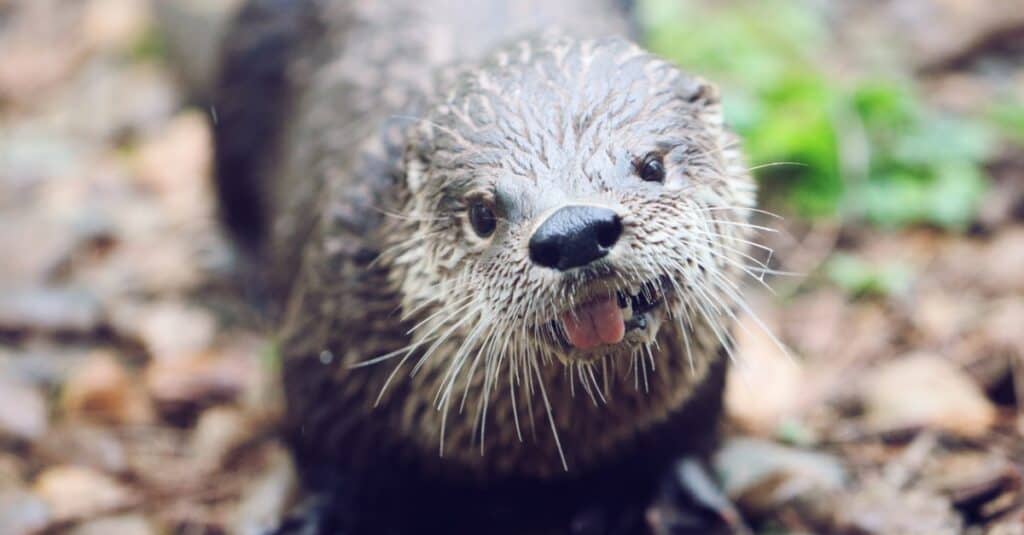Many creatures dwell in the water, and some of them are difficult to tell apart. For example, the seal and otter are two animals that have a lot in common and are often confused for one another. They’re both known for spending a lot of time in the water, something that is unusual for mammals that don’t spend their entire lives in water. Still, these mammals are very different from one another, and we’re going to show you the differences between a seal vs otter. Learn how to tell them apart quickly and easily!
Comparing a Seal and an Otter

| Seal | Otter | |
| Size | Weight: 105lbs-6,000lbs Length 5ft- 20ft | Weight: 10lbs-99lbs Length: 2ft-6ft |
| Family | Phocidae | Mustelidae |
| Thermoregulation | – Blubber deposits under the skin keep “true seals” warm – Fur seals use blubber and fur to stay warm | -Dense fur that has two layers, guard hairs, and insulating underfur |
| Morphology | – Have flippers used to help swim – True seals do not have visible ears – Have a very small nub of a tail between their hind flippers | – Have paws that they can use to “hold hands” with other otters so they don’t drift apart – Possess external ears – Have a long, thin, pronounced tail |
| Preference for Water or Land | – Spend equal amounts of time on land and in the water | – Spend the vast majority of their time in the water |
The Key Differences Between Seal vs Otter

Otters and seals have very different bodies in terms of fur, ears, and tails
©iStock.com/Heather Burditt
The key differences between seals and otters are size, family, and their method of thermoregulation. Seals are larger than otters, weighing a lot more than them and growing much longer. Although seals and otters are often believed to be related, the truth is that they belong to completely different families.
Seals belong to Phocidae, and otters belong to the Mustelidae, so they are not even close to being related. Lastly, seals use blubber under their thick skin to keep them warm when they spend time in the water, but otters have dense, two-layered fur that keeps them insulated.
These are the major differences between seals and otters, and their unique qualities become even more prominent when you look closer at these two creatures.
Seal vs Otter: Size

Elephant
seals can weigh as much as 6,000lbs!
©creativex/Shutterstock.com
Seals are larger than otters on average, and the largest members of the species make otters look positively tiny. The elephant seal can weigh up to 6,000lbs and grows 20ft long. The largest otter, the river otter, only weighs about 100lbs when it reaches its full weight, and it grows about 6ft long.
Both seals and otters can vary a great deal in their sizes owing to their various species. Nevertheless, seals tend to be much larger than otters. If you see a vast creature, then it’s probably a seal and not an otter. Yet, if the two creatures are closer in size, then you will need to rely on other methods of differentiating them.
Seal vs Otter: Family
Seals belong to the Phocidae family, and otters belong to the Mustelidae family. Members of Phocidae are known as earless seals or true seals. They are mammals without fur as adults. They are very different from other mammals that share the seal’s name or lineage. Fur seals are not members of Phocidae, and they are not true seals either.
The Mustelidae family is very unique and encompasses about 70 different species of animals including otters, wolverines, badgers, and more. Thus, an otter is more closely related to a wolverine than it is to a seal.
Although it’s not a visible means of telling the creatures apart, knowing their family can help distinguish the creatures.
Seal vs Otter: Thermoregulation
True seals use blubber deposits under their skin to keep themselves warm when they’re in the water, which is quite often. Otters use two layers of dense fur to keep warm when they are submerged in the water, and that is most of their lives.
Otters’ fur has guard hairs on the outside layer that are used to keep them protected from moisture and to maintain body temperature. The underfur is the layer closest to the body, and this fur functions to insulate their body and keep warm in very cold conditions.
Some seals have fur, but they are not considered true seals. For example, sea lions are sometimes believed to be seals, but that is not the case. These animals use both fur and blubber to keep warm, and that is one of many ways to differentiate between true seals and others.
Seal vs Otter: Morphology

Otters use their paws to keep their partners close in the water
©nvphoto/Shutterstock.com
Seals have flippers, no visible external ears, and a very small tail. Otters have webbed paws instead of flippers, visible external ears, and a long, thin tail that is easy to spot. Their unique bodies make it easy to tell the creatures apart.
For example, if you see a creature with flippers and no tail or ears, it’s clearly a seal rather than an otter. However, when you add seals that aren’t true seals to the mix, the presence of ears can be a confounding factor.
Otters’ webbed paws are interesting because sea otters will hold hands with their partners, so they don’t drift too far apart from their group. Not only is this useful for staying together, but it also keeps them away from the shore where many of their predators reside.
Seal vs Otter: Preference for Water or Land

Seals spend about half their time on land and the other half in water
©vladsilver/Shutterstock.com
Seals spend less time in the water than otters. Otters spend the vast majority of their time in the water, and they even sleep in the water. However, seals split their time on land and in the water almost evenly. They are not very graceful on land because of their flippers, but they manage to move very well in the water.
Seals and otters are easy to tell apart if you know where to look. Your best bet for differentiating these animals is to look for their ears, flippers, tails, size, and fur. You’ll have a very simple time determining if you are looking at an otter from a true seal with one or two of those factors.
The photo featured at the top of this post is © nyker/Shutterstock.com
Thank you for reading! Have some feedback for us? Contact the AZ Animals editorial team.






